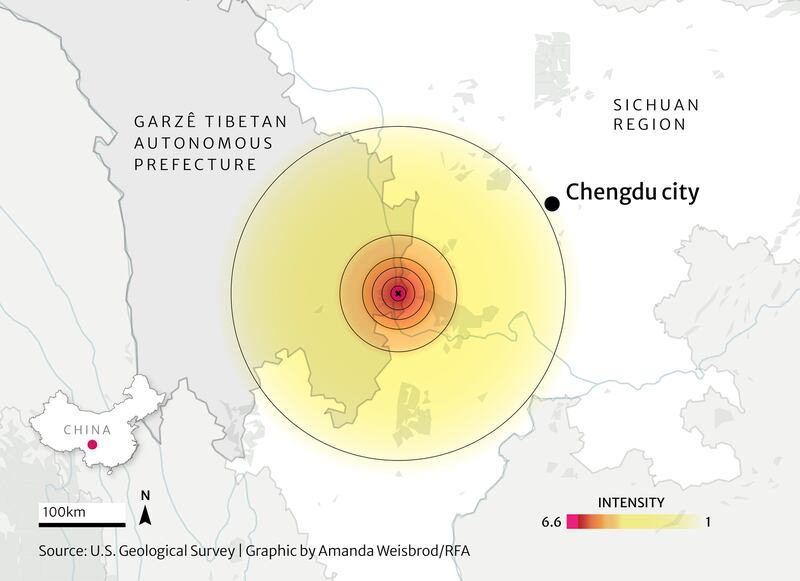UPDATED at 3:35 P.M. EDT on 2022-09-06
Rescue workers in the southwestern Chinese province of Sichuan scrambled to evacuate and assist thousands of victims of Monday's 6.8-magnitude earthquake that rocked Luding county, which has left at least 66 people dead and 253 others injured, according to the latest official Chinese figures.
Ruling Chinese Communist Party (CCP) leader Xi Jinping's call for "all-out relief efforts ... prioritizing saving lives and minimizing casualties" featured prominently on the front pages of state-controlled media outlets on Tuesday.
A resident of Moxi township, not far from the epicenter that was measured at 200 kilometers (124 miles) from the provincial capital Chengdu, said the epicenter was in the Hailuogou scenic tourist region just a few kilometers outside the town.
"Basically, a lot people were crushed under [collapsed] houses in their own homes; most of the deaths and casualties were crushed under houses," the resident, who gave only the surname Li, told RFA earlier on Tuesday.
"The official announcement is that 29 people died in Kardze prefecture, with the total number of 46 deaths, including deaths in Shimian county and villages around the Hailuogou area," Li said at the time. "For example, some people were trapped under landslides when they were walking along the road."

Li said the rescue efforts had been "very fast" to appear in the region.
Many of the buildings around Hailuogou were built to rent out to tourists using apps, Li said.
"A lot of people around Hailuogou borrowed money, or their relatives gave them money, and they built these houses with loans," Li said, adding that the government had insisted that local people develop the tourist industry rather than living off the proceeds of illegal logging.
"Many had lost their land, and had no income, so they thought they'd invest in these guesthouses and restaurants, all on the back of borrowing, but the government doesn't make long-term plans," he said, adding that there was poor safety supervision of the new buildings springing up in an earthquake-prone area.
A Tibetan source in the area told RFA on condition of anonymity that residents have been told they aren't out of the woods yet.
“Tibetans residing in the cities are now staying in temporary tents built on open grounds and Chinese authorities have advised to continue to remain alert and prepared”.
Meanwhile, authorities in Chengdu continued to enforce a citywide COVID-19 lockdown despite buildings splitting and shaking in the city, according to video clips uploaded to social media.
Resident Wang Yan said she felt the quake very strongly in her apartment.
"I was at home, and started to feel dizzy — the stool I was sitting on swayed around," Wang said. "I wanted to get up and go to the toilet, but I couldn't stand up."
"It was like trying to walk on cotton cloth, and it kept swaying for a long time," she said.
A resident of Mianyang, which was worst-hit during the May 12, 2008, quake that left 89,000 dead, said they saw strange animal behaviors shortly before the quake hit.
"There were bats and birds grouped together, flying around, and fish in the fish-ponds round here started jumping out of the water," the resident said. "People said it meant there was going to be an earthquake."
"Sure enough, it had happened within eight hours," the person said.

Emergency response level raised
Late on Monday night, Kardze Tibetan Autonomous Prefecture, where Luding county is located, raised its prefectural emergency response for earthquakes to level-I, the highest in the four-tier emergency response system, the Global Times reported.
It cited "media reports" and Sichuan officials as saying that more than 6,500 rescue workers, including firefighters and armed police, had been dispatched to the area, along with four helicopters and two drones, while more than 50,000 residents had been evacuated.
The Xi'an Satellite Control Center has deployed satellite Gaofen-3 to enable satellite users to receive remote sensing images of the earthquake-hit regions in a timely manner, enabling experts to assess ongoing risks in the disaster zone.
A Twin-Tailed Scorpion drone was dispatched to assist in inspections and communication coverage at 5.00 p.m. local time, to restore cell phone signals for local residents and rescue teams, the paper said.
A large number of residential communities had warned local residents of the quake in advance through loudspeakers across Sichuan, while tens of millions of residents saw the warnings on TV or through mobile phones, as did epidemic prevention and control staffers.
"They were able to take emergency shelter in a timely manner," it quoted a government statement as saying, adding that some 150 million yuan in funding was being channeled into the relief effort.
Translated and edited by Luisetta Mudie.
The story was updated to include the latest official figures on the number of people killed and injured as well as a quote by a Tibetan who lives in the area.
